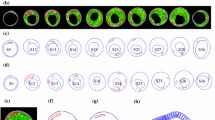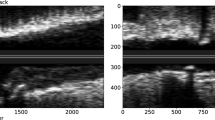Abstract
Plaque progression and vulnerability are influenced by many risk factors. Our goal is to find a simple method to combine multiple risk factors for better plaque development prediction. Intravascular ultrasound data at baseline and follow-up were acquired from nine patients, and fluid–structure interaction models were constructed to obtain plaque wall stress/strain (PWS/PWSn) and wall shear stress (WSS). Two hundred fifty-four slices with noticeable change in plaque burden were selected for analyses. Data of six key morphological and biomechanical factors were extracted from each slice at baseline to predict plaque development measured by plaque burden increase (PBI) from baseline to follow-up. A multi-factor decision-making strategy was proposed to assign a binary predictive outcome YW (W represents any combination of these six factors) based on simple “threshold value” idea to predict the ground truth YPBI: YPBI = 1 if PBI > 0; YPBI = 0 otherwise. A fivefold cross-validation procedure was employed to identify the optimal predictor among all possible combinations. The results showed that PWS was the best single-factor predictor for PBI with a prediction accuracy of 63.0%. Among all 63 combinations, combining lipid percent, PWS and WSS gave the optimal predictor, achieving a prediction accuracy of 68.1%. This demonstrated that compared to single factor alone, integrating morphological and biomechanical factors would lead to higher prediction accuracy. The simple method could be extended to combine factors from different sources to improve prediction accuracy. Efforts in mechanical analysis and modeling automation are needed to bring this strategy closer to potential clinical applications.



Similar content being viewed by others
References
Agatston AS, Janowitz WR, Hildner FJ, Zusmer NR, Viamonte M Jr, Detrano R (1990) Quantification of coronary artery calcium using ultrafast computed tomography. J Am Coll Cardiol 15:827–832
Bathe KJ (1996) Finite element procedures. Prentice Hall, Englewood Cliffs
Bathe KJ (2002) Theory and modeling guide, vol I: ADINA; vol II: ADINA-F. Adina R & D Inc., Watertown
Bluestein D, Alemu Y, Avrahami I, Gharib M, Dumont K, Ricotta JJ, Einav S (2008) Influence of microcalcifications on vulnerable plaque mechanics using FSI modeling. J Biomech 41(5):1111–1118
Cheng GC, Loree HM, Kamm RD, Fishbein MC, Lee RT (1993) Distribution of circumferential stress in ruptured and stable atherosclerotic lesions: a structural analysis with histopathological correlation. Circulation 87:1179–1187
Falk E, Shah PK, Fuster V (1995) Coronary plaque disruption. Circulation 92:657–671
Fung YC, Liu SQ (1992) Strain distribution in small blood vessel with zero-stress state taken into consideration. Am J Physiol 262(2):H544–H552
Giddens DP, Zarins CK, Glagov S (1993) The role of fluid mechanics in the localization and detection of atherosclerosis. J Biomech Eng 115:588–594
Gijsen FJH, Nieuwstadt HA, Wentzel JJ, Verhagen HJM, van der Lugt A, van der Steen AFW (2015) Carotid plaque morphological classification compared with biomechanical cap stress: implications for a magnetic resonance imaging-based assessment. Stroke 46:2124–2128
Glagov S, Wisenberg E, Zarins CK, Stankunavicius R, Kolettis GJ (1987) Compensatory enlargement of human atherosclerotic coronary arteries. N Engl J Med 316:1371–1375
Guo X, Zhu J, Maehara A, Monoly D, Samady H, Wang L, Billiar KL, Zheng J, Yang C, Mintz GS, Giddens DP, Tang D (2017) Quantify patient-specific coronary vessel material property and its impact on plaque stress/strain calculations using in vivo IVUS data and 3D FSI models: a pilot study. Biomech Model Mechanobiol 16(1):333–344
Guo X, Giddens DP, Molony D, Yang C, Samady H, Zheng J, Mintz GS, Maehara A, Wang L, Pei X, Li ZY, Tang D (2018) Combining IVUS and optical coherence tomography for more accurate coronary cap thickness quantification and stress/strain calculations: a patient-specific three-dimensional fluid-structure interaction modeling approach. J Biomech Eng 140(4):041005
Holzapfel GA, Gasser TC, Ogden RW (2000) A new constitutive framework for arterial wall mechanics and a comparative study of material models. J Elast Phys Sci Solids 61(1):1–48
Kafi O, Khatib NE, Tiago J, Sequeira A (2017) Numerical simulations of a 3D fluid-structure interaction model for blood flow in an atherosclerotic artery. Math Biosci Eng 14(1):179–193
Kelly-Arnold A, Maldonado N, Laudier D, Aikawa E, Cardoso L, Weinbaum S (2013) Revised microcalcification hypothesis for fibrous cap rupture in human coronary arteries. Proc Natl Acad Sci USA 110(26):10741–10746
Ku DN, Giddens DP, Zarins CK, Glagov S (1985) Pulsatile flow and atherosclerosis in the human carotid bifurcation: positive correlation between plaque location and low and oscillating shear stress. Arteriosclerosis 5:293–302
Kural MH, Cai M, Tang D, Gwyther T, Zheng J, Billiar KL (2012) Planar biaxial characterization of diseased human coronary and carotid arteries for computational modeling. J Biomech 45(5):790–798
Liu X, Wu G, Xu C, He Y, Shu L, Liu Y, Zhang N, Lin C (2017) Prediction of coronary plaque progression using biomechanical factors and vascular characteristics based on computed tomography angiography. Comput Assist Surg 22(Sup1):286–294
Loree HM, Kamm RD, Stringfellow RG, Lee RT (1992) Effects of fibrous cap thickness on peak circumferential stress in model atherosclerotic vessels. Circ Res 71:850–858
Lusis AJ (2000) Atherosclerosis. Nature 407(6801):233–241
Mintz GS (2014) Clinical utility of intravascular imaging and physiology in coronary artery disease. J Am Coll Cardiol 64:207–222
Mintz GS (2015) Intravascular imaging of coronary calcification and its clnical implications. J Am Coll Cardiol Imaging 8:261–471
Ohayon J, Dubreuil O, Tracqui P, Le Floc’h S, Rioufol G, Chalabreysse L, Thivolet F, Pettigrew RI, Finet G (2007) Influence of residual stress/strain on the biomechanical stability of vulnerable coronary plaques: potential impact for evaluating the risk of plaque rupture. Am J Physiol Heart Circ Physiol 293(3):H1987–H1996
Ohayon J, Finet G, Gharib AM, Herzka DA, Tracqui P, Heroux J, Rioufol G, Kotys MS, Elagha A, Pettigrew RI (2008) Necrotic core thickness and positive arterial remodeling index: emergent biomechanical factors for evaluating the risk of plaque rupture. Am J Physiol Heart Circ Physiol 295(2):H717–H727
Richardson PD, Davies MJ, Born GVR (1989) Influence of plaque configuration and stress distribution on fissuring of coronary atherosclerotic plaques. Lancet 334(8669):941–944
Samady H, Eshtehardi P, McDaniel MC, Suo J, Dhawan SS, Maynard C, Timmins LH, Quyyumi AA, Giddens DP (2011) Coronary artery wall shear stress is associated with progression and transformation of atherosclerotic plaque and arterial remodeling in patients with coronary artery disease. Circulation 124:779–788
Schoenhagen P, Ziada KM, Vince G, Nissen SE, Tuzcu EM (2001) Arterial remodeling and coronary artery disease: the concept of “dilated” versus “obstructive” coronary atherosclerosis. J Am Coll Cardiol 38:297–306
Spence DJ, Eliasziw M, DiCicco M, Hackam DG, Galil R, Tara Lohmann (2002) Carotid plaque area: a tool for targeting and evaluating vascular preventive therapy. Stroke 33:2916–2922
Stary HC, Chandler AB, Dinsmore RE, Fuster V, Glagov S, Insull W Jr, Rosenfeld ME, Schwartz CJ, Wagner WD, Wissler RW (1995) A definition of advanced types of atherosclerotic lesions and a histological classification of atherosclerosis: a report from the committee on vascular lesions of the council on arteriosclerosis, American Heart Association. Circulation 92(5):1355–1374
Stone GW, Mintz GS (2010) Letter by Stone and Mintz regarding article, “Unreliable assessment of necrotic core by virtual histology intravascular ultrasound in porcine coronary artery disease”. Circ Cardiovasc Imaging 3:e4
Stone GW, Maehara A, Lansky AJ, de Bruyne B, Cristea E, Mintz GS, Mehran R, McPherson J, Farhat N, Marso SP, Parise H, Templin B, White R, Zhang Z, Serruys PW, Investigators PROSPECT (2011) A prospective natural-history study of coronary atherosclerosis. N Engl J Med 364(3):226–235
Stone PH, Saito S, Takahashi S et al (2012) Prediction of progression of coronary artery disease and clinical outcomes using vascular profiling of endothelial shear stress and arterial plaque characteristics: the PREDICTION Study. Circulation 126(2):172–181
Tang D, Teng Z, Canton G, Hatsukami TS, Dong L, Huang X, Yuan C (2009) Local critical stress correlates better than global maximum stress with plaque morphological features linked to atherosclerotic plaque vulnerability: an in vivo multi-patient study. Biomed Eng Online 8:15
Tang D, Kamm RD, Yang C, Zheng J, Canton G, Bach R, Huang X, Hatsukami TS, Zhu J, Ma G, Maehara A, Mintz GS, Yuan C (2014) Image-based modeling for better understanding and assessment of atherosclerotic plaque progression and vulnerability: data, modeling, validation, uncertainty and predictions. J Biomech 47(4):834–846
Teng Z, Sadat U, Li Z, Huang X, Zhu C, Young VE, Graves MJ, Gillard JH (2010) Arterial luminal curvature and fibrous-cap thickness affect critical stress conditions within atherosclerotic plaque: an in vivo MRI-based 2D finite-element study. Ann Biomed Eng 38(10):3096–3101
Teng Z, Zhang Y, Huang Y, Feng J, Yuan J, Lu Q, Sutcliffe MP, Brown AJ, Jing Z, Gillard JH (2014) Material properties of components in human carotid atherosclerotic plaques: a uniaxial extension study. Acta Biomater 10:5055–5063
Thim T, Hagensen MK, Wallace-Bradley D, Granada JF, Kaluza GL, Drouet L, Paaske WP, Bøtker HE, Falk E (2010) Unreliable assessment of necrotic core by virtual histology intravascular ultrasound in porcine coronary artery disease. Circ Cardiovasc Imaging 3:384–391
Virmani R, Kolodgie FD, Burke AP, Farb A, Schwartz SM (2000) Lessons from sudden coronary death: a comprehensive morphological classification scheme for atherosclerotic lesions. Arterioscler Thromb Vasc Biol 20(5):1262–1275
Virmani R, Ladich ER, Burke AP, Kolodgie FD (2006) Histopathology of carotid atherosclerotic disease. Neurosurgery 59(5 Suppl 3):S219–S227
Wang L, Zheng J, Maehara A, Yang C, Billiar KL, Bach R, Muccigrosso D, Mintz GS, Tang D (2015) Morphological and stress vulnerability indices for human coronary plaques and their correlations with cap thickness and lipid percent: an IVUS-based fluid-structure interaction multi-patient study. PLoS Comput Biol 11(12):e1004652
Wang L, Tang D, Maehara A, Wu Z, Yang C, Muccigrosso D, Zheng J, Bach R, Billiar KL, Mintz GS (2018) Fluid-structure interaction models based on patient-specific IVUS at baseline and follow-up for prediction of coronary plaque progression by morphological and biomechanical factors: a preliminary study. J Biomech 68:43–50
Ward MR, Pasterkamp G, Yeung AC, Borst C (2000) Arterial remodeling: mechanisms and clinical implications. Circulation 102:1186–1191
Yang C, Tang D, Yuan C, Hatsukami TS, Zheng J, Woodard PK (2007) In vivo/ex vivo MRI-based 3D non-Newtonian FSI models for human atherosclerotic plaques compared with fluid/wall-only models. CMES: Comput Model Eng Sci 19(3):233–245
Yang C, Bach R, Zheng J, El Naqa I, Woodard PK, Teng ZZ, Billiar KL, Tang D (2009) In vivo IVUS-based 3D fluid structure interaction models with cyclic bending and anisotropic vessel properties for human atherosclerotic coronary plaque mechanical analysis. IEEE Trans Biomed Eng 56(10):2420–2428
Acknowledgements
This research was supported in part by US NIH/NIBIB (Grant No. R01 EB004759), National Natural Science Foundation of China (Grant Nos. 11672001 and 11802060), the Natural Science Foundation of Jiangsu Province (Grant No. BK20180352) and a Jiangsu Province Science and Technology Agency (Grant No. BE2016785).
Author information
Authors and Affiliations
Corresponding authors
Ethics declarations
Conflict of interest
There is no conflict of interest to disclose.
Additional information
Publisher’s Note
Springer Nature remains neutral with regard to jurisdictional claims in published maps and institutional affiliations.
Rights and permissions
About this article
Cite this article
Wang, L., Tang, D., Maehara, A. et al. Multi-factor decision-making strategy for better coronary plaque burden increase prediction: a patient-specific 3D FSI study using IVUS follow-up data. Biomech Model Mechanobiol 18, 1269–1280 (2019). https://doi.org/10.1007/s10237-019-01143-3
Received:
Accepted:
Published:
Issue Date:
DOI: https://doi.org/10.1007/s10237-019-01143-3




